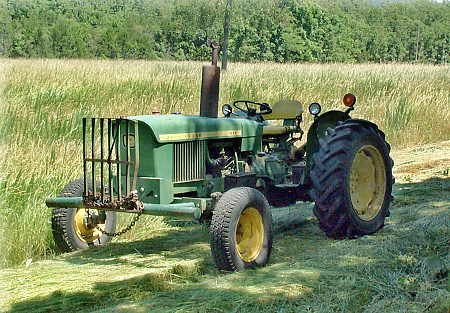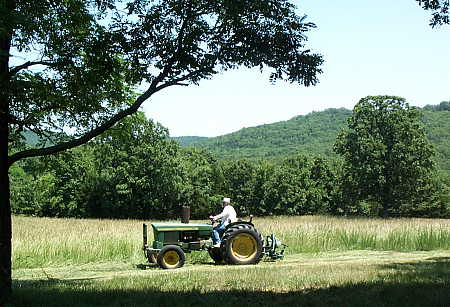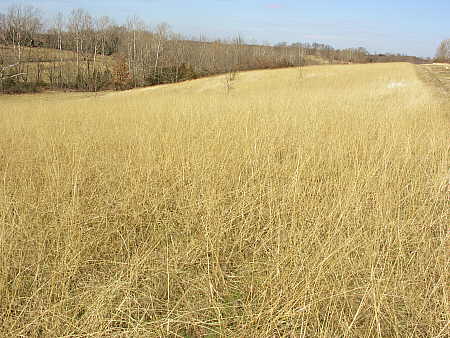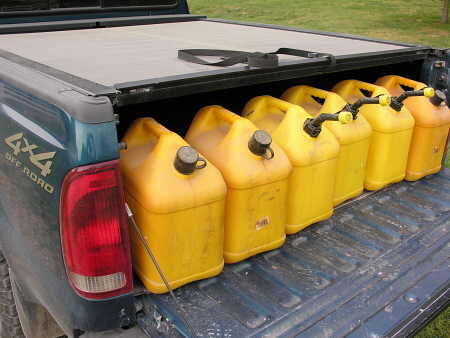
The photo above shows how we obtain our off-road diesel fuel to supply the needs of our tractor. In order to purchase off-road diesel (which is devoid of state road taxes), we must travel 16 miles each way to the nearest supplier. Safe fuel handling practices dictate that fuel containers be removed from the bed of the truck before filling, so we place the cans on the ground to pump fuel into them. The containers are then lifted back into the bed of the truck for the journey home, where they are off-loaded from the truck and carried into the barn for storage. When it is time to fuel the tractor, a container is carried from the barn out to the tractor, where it is emptied by hand into the tractor’s fuel tank. If I were to attempt this feat while standing on the ground, then the fuel filler neck would be at eye-level, which is not a particularly safe way to fill a tank with hazardous liquids! As you can see from the photo below, by elevating the bush-hog into the uppermost position, I can accomplish the refueling from a position that affords eye safety. On the other hand, it isn’t a position that is easy on the back!  Ouch!!!
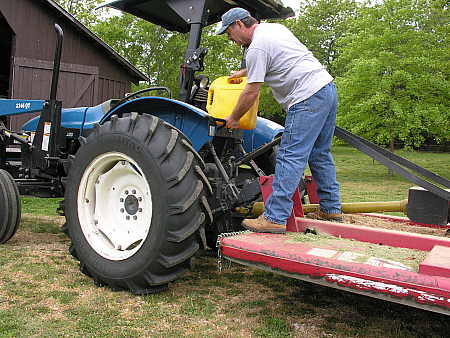
Now let us do some math. Ouch!!! Okay, I’ll do the math, you just follow along with my reasoning. This tractor burns 1 gallon of fuel per hour. According to the tractor’s hour meter, I have run the tractor for a total of 1200 hours in the past 5 years. That amounts to 1200 gallons of diesel fuel. There seems to be some controversy over the weight of diesel fuel, but assuming a conservative 7 pounds per gallon as the factor, that translates into 8400 pounds of diesel fuel that the tractor has consumed. Each gallon of fuel had to be handled several times; 1) loaded onto the truck for the ride home, 2) transferred from the truck to the barn 3) carried from the barn to the tractor 4) lifted and poured into the tractor’s fuel tank. So now we have determined that I have handled a total of 33,600 pounds, or nearly 17 TONS of fuel! Ouch!!! No wonder my back sometimes hurts.
Now for some more math. Ouch!!! As you can see from the first photo, I fill 6 fuel cans at a time, because that is the number that will fit across the back of the pickup bed, affording lateral stability as I wind my way around the Ozarks landscape on my way to the filling station. I fill each container with 4.5 gallons of fuel, therefore each round trip to the station yields 27 gallons of fuel (4.5 X 6). We know from the paragraph above that we have used a total of 1200 gallons of diesel fuel, therefore we can conclude that there has been a total of 44 round trips made to obtain this fuel (1200/27=44.44). Now if we multiply the 44 round trips by 32 miles, we obtain 1408 miles traveled to fetch diesel fuel. Dividing by the abysmal 16 miles/gallon that my truck manages to achieve (he admits, covering his face in shame), and then multiplying by an average fuel price of, say, $2.00/gallon, we can determine that I have spent close to $200 just to fetch the fuel! Ouch!!! No wonder my wallet sometimes hurts.
As an aside, well, I’m almost too embarrassed to share it with you, but here goes. Over the years, I have been purchasing off-road diesel fuel for use in my tractor. As mentioned previously, off-road diesel fuel is devoid of road taxes. Sometime in the past (I don’t know when), the state legislature decided that off-road diesel should be subject to the state sales tax of 7%. So now, using today’s fuel prices, the calculus (ouch!!!) goes something like this:
Off-road diesel (16 miles away)= $2.65/gal + 7% sales tax = $2.84/gallon
On-road diesel (available locally) = $2.79/gallon
Price of my embarrassment = ???  Ouch!!!Â
But I digress.
My father used to frequently say “Son, the legs go first!” But then, he spent the better part of his life running a factory. He put many miles on the soles of his shoes, so one would expect the legs to go first.  While I do lots of hiking around the property here, I find that I am called upon to perform heavy lifting much more than I recall doing since my younger days. And so I would have to say “Dad, the back goes first!”
So the question that nags at me is this – is there a better way to accomplish this task of fueling the tractor, which, while seeming to be a trivial task, can wreak havoc on the backs of those of us who don’t feel as young as we once were?
One popular option that many farmers turn to involves the installation of an elevated, above-ground fuel storage tank, which is periodically replenished by a local fuel distributor.  These systems are gravity driven, which is both a blessing and a bane. A blessing, because pumping equipment is not required. A bane, because gravity cannot be shut off. There are many potential points of leakage in a fueling system. With gravity continuously at work, any leakage, no matter how slight, will eventually empty the tank. There was an incident that occurred about 5 years ago in an area around Beaver Lake, about 75 miles away. A fishing resort owner had a 300 gallon elevated tank installed for the convenience of his guests. The tank valve developed a leak sometime during the night, and approximately 200 gallons of fuel seeped into the water table. To make a long story short, 5 years later there are about 100 households with contaminated wells. Their water has to be delivered weekly by truck and pumped into plastic holding tanks placed on their property. The owners of the resort had to declare bankruptcy when their insurance policy reached the limit of the insurance company’s contracted liability. Ouch!!!Â
And this scenario, with some slight variations, is played out repeatedly across the country. As I was driving down the road this winter, I saw these tanks on a neighbors  farm, so I stopped to take a picture. To me, this looks like a disaster waiting to happen.Â
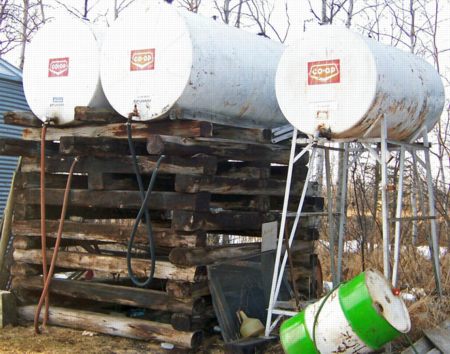
Were I to install a fuel tank, it would have to be built of quality parts. I would have to keep the tank, fittings, hose, valve and nozzle in tip-top condition. And the entire assembly would have have a seepage-proof containment system with capacity at least equal to the capacity of the tank. All-in-all, this would be a safe and effective system, which would certainly relieve the pains in my back, but man, would it be costly!
So it’s off to the station to fill those darn fuel cans. Ouch!!! Ouch!!! Ouch!!!








